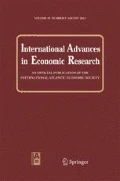Abstract
This paper seeks to explain exchange rate and current account or net foreign assets behavior under central bank foreign exchange rate intervention. To analyze central bank intervention we use the current account-net foreign assets identity, as well as the long-run monetary exchange rate model. The intervention function is one where exchange rate deviations from equilibrium are governed by nonlinear adjustments. That is, exchange rate deviations from their long-run equilibrium are such that the degree of reversion towards equilibrium increases with the size of the deviation from equilibrium. In this type of nonlinear function exchange rates determine the current account, and the current account in turn determines exchange rates. This iterative duality contrasts with several portfolio balance models where exchange rates are a function of trade, but trade is not a function of exchange rates. This two way causality is slightly more complex, but is also analytically richer than assuming that exchange rates change solely in a one step process as targeted by central banks. Managing exchange rates is posited to be an active iterative feedback process where intervention changes the current account, which may in turn make further intervention necessary.
Similar content being viewed by others
References
Devereux, M. B. “How Does a Devaluation Affect the Current Account?,”Journal of International Money and Finance, 19, 2000, pp. 833–51.
Dornbusch, Rudiger. “Expectations and Exchange Rate Dynamics,”Journal of Political Economy, December, 1976, pp. 1161–76.
__; Fischer, Stanley. “Exchange Rates and the Current Account,”American Economic Review, December, 1980, pp. 960–71.
Dumas, B. “Dynamic Equilibrium and the Real Exchange Rate in a Spatially Separated World,”Review of Financial Studies, 5, 2, 1992, pp. 153–80.
__. “Partial Equilibrium Versus General Equilibrium Models of the International Capital Market.” in Van der Ploeg, F., (Ed)The Handbook of International Macroeconomics, Blackwell, Oxford, 1994, pp. 301–47.
Edison, H. J. “The Effectiveness of Central Bank Intervention: A Survey of the Literature Since 1982,” University of Princeton Department of Economics Special Papers in International Economics, No 18, 1993.
Eichenbaum, Martin; Evans, Charles. “Some Empirical Evidence on the Effects of Monetary Policy Shocks on Exchange Rates,”Quarterly Journal of Economics, November, 1995, pp. 975–1110.
Flood, Robert P.; Garber, Peter M. “Collapsing Exchange Rate Regimes: Some Linear Examples,”Journal of International Economics, 1984, 17, 1–2, pp. 1–13.
Frenkel, J. “A Monetary Approach to the Exchange Rate: Doctrinal Aspects and Empirical Evidence,”Scandinavian Journal of Economics, June, 1976, pp. 255–76.
Flood, R. P.; Taylor, M. P. “Exchange Rate Economics: What's Wrong With the Conventional Macro Approach?,” in: Frankel, J. A., Galli, G., Giovannini, (Eds)The Microstructure of Foreign Exchange Markets, Chicago University Press, Chicago, 1996, pp. 261–94.
Froot, K. A.; Rogoff, K. “Perspectives on Purchasing Power Parity and Long-Run Real Exchange Rates,” in: Rogoff, K. and Grossman, G. (Eds).Handbook of International Economics, Vol. 3, North Holland, 1995, pp. 1647–88.
Lane, Philip R. “Inflation in Open Economies,”Journal of International Economics, May, 1997, 42 (3–4), pp. 327–47.
Lothian, J. R.; Taylor, M. P. “Real Exchange Rate Behavior: The Recent Float from the Perspectove of the Past Two Centuries,”Journal of Political Economy, 104, 3, 1996, pp. 488–510.
MacDonald, R.; Taylor, M. P. “The Monetary Model of the Exchange Rate: Long-Run Relationships, Short-Run Dynamics, and How to Beat a Random Walk,”Journal of International Money and Finance, 13, 3, 1994, pp. 276–90.
Mark, Nelson C. “Real and Nominal Exchange Rates in the Long-Run: An Empirical Investigation,”Journal of International Economics, 28 (1–2), 1990, pp. 115–36.
__; Sul, Donggyu. “Nominal Exchange Rates and Monetary Fundamentals: Evidence from a Small Post-Bretton Woods Panel,”Journal of International Economics, 53, 2001, pp. 29–52.
Meese, Richard; Rogoff, Kenneth. “Was it Real? The Exchange Rate-Interest Differential Over the Modern Floating-Rate Period,”Journal of Finance, 43, 1988, pp. 933–48.
Melvin, Michael.International Money and Finance, Harper Collins, New York, 1995, pp.170.
Mundell, Robert A. “The Appropriate use of Monetary and Fiscal Policy for Internal and External Stability,” International Monetary Fund Staff Papers, March 1962, pp. 70–9.
Neely, Christopher J. “The Practice of Central Bank Intervention: Looking Under the Hood,” Federal Reserve Bank of St. Louis Review, May/June 2001, pp. 1–10.
Niehans, Jurg. “Exchange Rate Dynamics with Stock/Flow Interaction,”Journal of Political Economy, 6, 83, 1977, pp. 1245–57.
Obstfeld, Maurice; Rogoff, Kenneth. “Exchange Rate Dynamics Redux,”Journal of Political Economy, June, 1995, pp. 624–60.
Rodriguez, Carlos Alfredo. “The Role of Trade Flows in Exchange Rate Determination: A Rational Expectations Approach,”Journal of Political Economy, 6, 88, 1980.
Rogoff, K. “The Purchasing Power Parity Puzzle,”Journal of Economic Literature, 34, 1996, pp. 647–68.
Sercu, P.; Uppal, R.; Van Hulle, C. “The Exchange Rate in the Presence of Transactions Costs: Implications for Tests of Purchasing Power Parity,” Journal of Finance, 1990, 50, 4, 1309–19.
Schnabl, Gunther. “Purchasing Power Parity and the Yen/Dollar Exchange Rate,”The World Economy, January, 2001, pp. 31–50.
Sarno, Lucius. “Toward a New Paradigm in Open Economy Modeling: Where Do We Stand?,” Federal Reserve Bank of St. Louis Review, May/June 2001, pp. 21–36.
__; Taylor, Mark P. “Official Intervention in the Foreign Exchange Markets: Is It Effective?,”Journal of Economic Literature, September, 2001, pp. 839-68.
Taylor, M. P.; Sarno, L. “The Behavior of Real Exchange Rates During the Post Bretton Woods Period,”Journal of International Economics, 46, 2, 1998, pp. 281–312.
Taylor, M. P.; Peel, David A. “Nonlinear Adjustment, Long-Run Equilibrium and Exchange Rate Fundamentals,”Journal of International Money and Finance, 19, 2000, pp. 33–53.
Author information
Authors and Affiliations
Rights and permissions
About this article
Cite this article
Larrain, M. Central bank intervention, the current account, and exchange rates. International Advances in Economic Research 9, 196–205 (2003). https://doi.org/10.1007/BF02295443
Issue Date:
DOI: https://doi.org/10.1007/BF02295443




